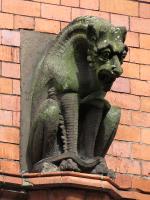
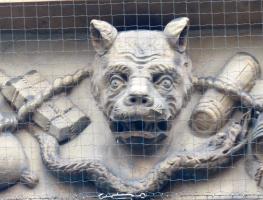

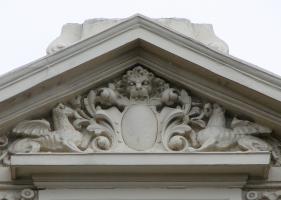

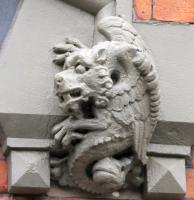
Liverpool contains a vast collection of architectural sculpture, and to walk the streets of this noble city is to be constantly greeted by views of the noblest of decorative arts. The artists and craftsmen of Victorian Liverpool had no limit to their imagination and inventiveness, and I particularly like the fantastic carved beasts which adorn the buildings, and this page shows a few of them. The materials are typically stone or unglazed ceramic in a variety of hues, and I have also included a couple of bronze examples.
We start with carved dragons – the two above left of are of the long, crocodilian sort, acting as corbels: roughly ball-shaped masses which nicely lend themselves to be carved into coiled bodies and tails. The third one is one of a pair on the corner to Westminster Chambers, Churchill Way, a distinctive landmark as the passer by turns to Preston Street. Then a small one with a charmingly curled tail, like a chameleon. More dragon sculpture on this page.
Victoria Street dragon or gargoyle sculpture.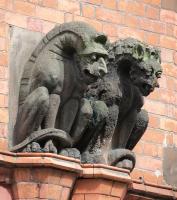
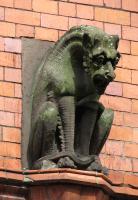
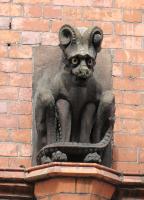
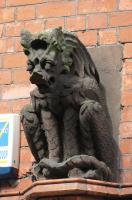
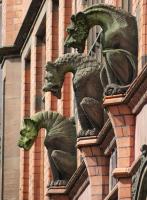
In Victoria Street, the Jerome and Carlisle Buildings have a fine procession of dragon-like gargoyles, peering down at the pedestrians. Each one has the same squatting pose and long bent neck, but is different in its detail, with a variety of fierce faces, scales or leathery skin, and taloned feet. The central one above is more like a crouching demon than a dragon.
From the three dimensional to the relief carving. First a standard dragon, of the two-legged, winged type, satisfyingly spiky. It fills the space nicely. Then a long frieze with a pair of dragonlike beasts, though with different heads they might have been griffins, and a variety of strapwork and two cornucopias. The beasts are part of the decorative scheme rather than dominant within it. The third example above redues the winged beasts to a subsidiary position, becoming part of the strapwork themselves. And the fourth example, far right, is a fishy dragon again slightly grotesqued, with the tail becoming the leafy surround for a flower.
Carved satyr heads are fairly popular in Liverpool. A satyr, one of the staples of ancient Greek pottery, is an athletic man-like creature with horns, a tail, and in Hellenic times at least, a penchant for pursuing young maidens. Above is a satyr head as a keystone above an arch, with ivy on his brow from which his curved goat-horns protrude. Next, a grotesque satyr, which is to say one where the shape and structure of the face has been made subordinate to the decorative effect. The horns are broad at the base and very curly, and the mouth is stretched wide, a feature of many grotesques. Next, an example of a satyr’s head forming part of the capital of a pillar; again, the mouth is stretched open. And then to the right, a satyr with very large horns, curling outward and down, and carved with something of a sad rather than fierce expression. A collection of satyr sculpture may be found on this page.
In Dale Street are some small statues of ogres, carved in wood rather than stone and acting as corbels, crouched down so that their backs and heads can be the supports for the wooden beams above. The first pair above seem to be a couple, grossly ugly, one with a dog, the other with a tied bag. The second pair includes one ogre with a wine jar on which perches a frog, while the other is some Bacchus-like figure with grapes. Also in Dale Street is the example above right, among his colleagues, doubtless inspired (if that is the right work for something so ugly) by the earlier carvings. With hideous head sunk down over the chest, tongue protruding, and his hands tucked into his loincloth, this figure is more of a gargoyle than a decoration. Note the hooves.
A couple more keystone heads before moving on to other things. To the left, a river god, with weedy beard and eyebrows, and fishes in his hair. This rather splendid head is a near copy of one in London, and ultimately derives from an 18th Century one on the frontage of Somerset House on the Strand (see this page). And the one on the right is a rather evil looking fellow, a pirate I think, with his scowl and sneer and earring, and snails crawling over his brow. Odd. There are many keystone sculptures featured on this site - start here.
Mermaids and mermen now. The Liverpool Coat of Arms includes a merman, as in this nice curved pediment carving above. Click on it to see the full pediment. Next, one of the disturbingly over-muscular mermen on the façade of no. 42, Castle Street. The third one is a beautiful mermaid from the Deco period, one of a pair. And the male equivalent, reminding us of the satyr’s heads we looked at before. The pair on the far right are tritons, thus with paired rather than single tails. Other mermaids may be found on this page, and mermen on this page.
Lions are not really mythical beasts, but I wanted to show a couple of the stylised Persian lion heads from Liverpool. Above left, a large bronze one, mouth wide open, quite dramatic. Then a smaller one, showing the classic circular mane. The third one is something very different – the feline face has been made more triangular, a satisfying composition, and the moustaches or lower mane exaggerated in size to form the spout of a fountain. The fourth one, a keystone, is somewhere between lion and man, a weird grotesque which nevertheless fits well to its frame and is nicely proportioned, a good example of a careful use of correct scale. If you like lion sculpture, see this page, and for carved lion heads, see this page.
Reptilian sculpture – above left, a primeval looking crocodile peering upwards, and to the right, a smaller reptile, carved as part of a decorative scheme.
Now some sculpture of aquatic beasts. Above, on the left are two sculptures with fishes. The first is a keystone, of the Classical dolphin type, and the next shows a predatory fish devouring a hapless smaller one (lots more fish sculpture on this page). Then a lampstand held by a pair of dragon seahorses, of a type also I think found in Cardiff. And then a strange little webfooted creature, a corbel again.
There are a fair number of freestanding sculptures of mythical beasts in Liverpool, and in the architectural context these can be used to give a more varied skyline, where they look most dramatic. The most significant examples in the City are on the great tower of the Municipal Buildings.
We cannot leave a page on Liverpool’s mythical beast sculpture without mentioning the Liver Bird of course. There is a whole page on this website devoted to these – here is the link – and we close this page with a single modest example.
Visits to this page from 9 Oct 2017: 6,998